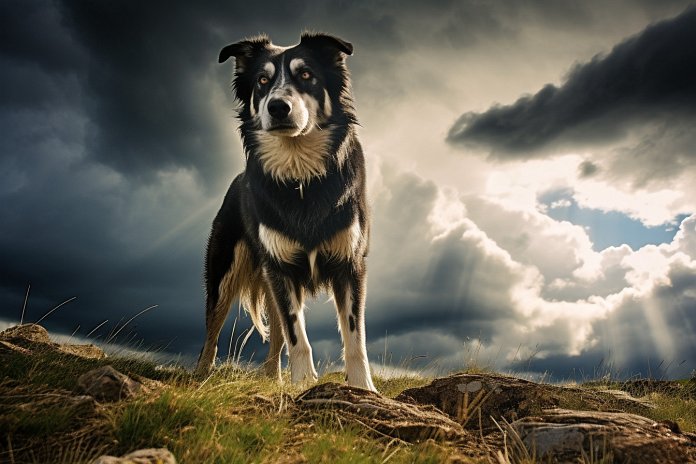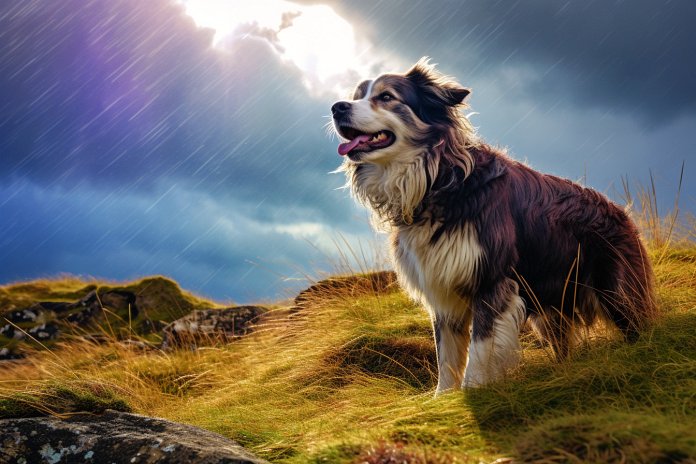
You may have heard the weather report predicting a storm, but your dog knows about it before you do. How do dogs sense that a storm is coming? Dogs have incredible senses. They can smell the rain, hear thunder before we do, detect changes in barometer pressure, and feel static electricity from lightning. All of these factors allow dogs to stay informed about weather changes.
Signs Your Dog is Sensing a Storm
Dogs can sense a storm before it happens, and some dogs handle it with ease. They may twitch their nose, prick up their ears, or feel a bit uncomfortable as the air changes, thunder sounds in the distance, or the pressure drops and dark clouds form. You might notice your dog hiding under the bed, seeking extra attention, or exhibiting signs of anxiety right before a storm hits. Dogs that are phobic of storms may panic, whine, pant, shiver, shake, and fear the shocks from lightning.
Body Language
If your dog is sensing a storm, look for signs such as listening, shaking, cowering, howling, and whimpering.
Other Signs
Other signs that your dog can sense a storm include hiding away, wanting to stay close to you, urinating, and exhibiting destructive behavior.
The History of Dogs Sensing Storms
Dogs have always been aware of storms. Before they were domesticated, dogs sought shelter in burrows, caves, or forests when storms approached. There is an inspiring story about a hybrid wolf/dog named Shana who rescued her owners during a snowstorm by digging a tunnel for them. Shana was recognized for her bravery and awarded the Hero’s Award for Bravery.
The Science of Dogs Sensing Storms
Scientists and veterinarians acknowledge that dogs have strong senses and can feel changes in their environment. Dogs’ sensitivity to storms is believed to be related to the static electricity caused by lightning. Dogs may also experience shocks from lightning and seek shelter in grounded places. They can sense changes in ozone, humidity, and vibrations caused by thunder.
Training Dogs to Cope Through Storms
Dogs have varying levels of sensitivity to storms. Some may just seek comfort during a storm, while others may have a fear of storms. Desensitization techniques can help dogs overcome their fear, such as using a CD recording of a storm, providing safe jackets for calming, creating a shelter room, and spending time with your dog in that room. Other fears like noise or separation anxiety should also be addressed. If your dog exhibits extreme fear, consult a veterinarian for medication or herbal remedies to keep them calm during storms.
“Storms may be in the forecast, but your dog’s senses have already detected the impending weather change.”

Tips & Things to Know
1️⃣ Dogs have superior senses that allow them to sense a storm before it happens. They can detect changes in smell, sound, barometer pressure, and static electricity caused by lightning.
2️⃣ Signs that your dog is sensing a storm include twitching of the nose, pricking up of the ears, shivering, shaking, hiding, pawing for attention, and exhibiting anxious behaviors such as whining, panting, and urinating.
3️⃣ If your dog is fearful of storms, there are ways to help them cope. Desensitization techniques, such as using recordings of storms, creating a safe haven with toys and a crate, and using calming wraps or bedding, can be effective. Consulting a veterinarian for medication or herbal remedies may also be beneficial for dogs with extreme fear and anxiety.
Frequently Asked Questions, Answered ✅
1. How do dogs know when a storm is coming?
– Dogs have superior senses, including smell, hearing, and sensitivity to changes in barometric pressure and static electricity, which allow them to sense a storm before it happens.
2. What are some signs that a dog is sensing a storm?
– Some signs include twitching of the nose, pricking up of ears, discomfort or shivering from static electricity, hiding or seeking shelter, and seeking extra attention from their owner.
3. Why are some dogs petrified of storms?
– Some dogs may have a phobia of storms due to fear of thunder, loud wind sounds, rain, and static electricity shocks. Previous traumatic experiences or abuse during storms can also contribute to their fear.
4. What are some body language signs that indicate a dog is sensing a storm?
– Body language signs may include listening intently, shaking, cowering, howling, whimpering, hiding away, wanting to stay close to their owner, urinating, and exhibiting destructive behavior.
5. How can dogs be trained to cope with storms?
– De-sensitizing techniques can be used, such as exposing the dog to recorded storm sounds, creating a safe and comfortable haven in a designated room, using calming jackets or bedding to reduce static electricity, and addressing any other underlying phobias or anxieties through behaviorist assistance and veterinarian guidance.